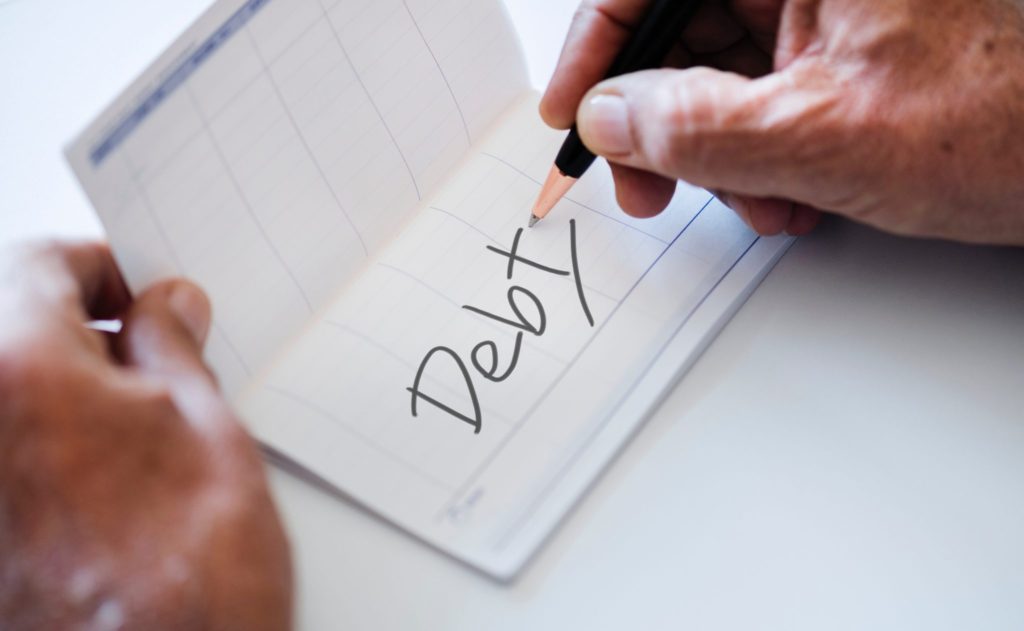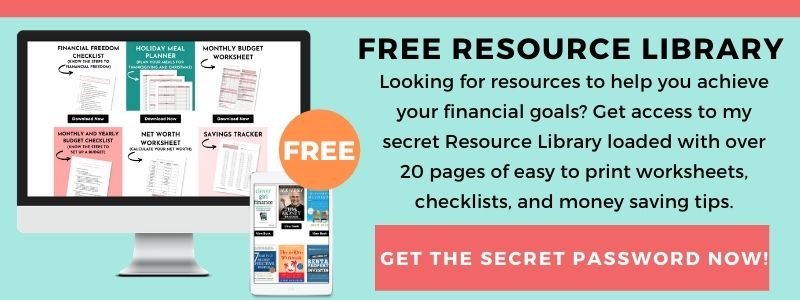Last Updated October 20, 2021
Do you have debt? I sure do. We all have debt, in one form or another. The problem is that debt isn’t just a little bit of money, it’s usually at least tens of thousands of dollars! I paid off over $100,000 in debt fast with the help of a debt snowball spreadsheet. If you are looking for one, I created mine and would love to share it with you so you can make a debt payoff plan and get out of debt quickly!
What Is A Debt Payoff Plan?
A debt payoff plan is a debt repayment strategy you make so you can pay off your debts. When you make a debt payoff plan, you know the exact action steps you need to take to pay off your debt as fast as possible.
How To Make A Debt Payoff Plan?
To make a debt payoff plan you have to first educate yourself about the different ways to pay off debt. The two most popular methods to pay off debt are 1) the debt snowball method and 2) the debt avalanche method.
Once you educate yourself you can make a plan to pay off your debt.
How Does The Debt Snowball Method Work?
You may have heard of the debt snowball method made famous by Dave Ramsey. Dave Ramsey’s debt snowball method is a way to pay off your debt in order of smallest debt balances to largest debt balances. You make minimum payments on all debts except the one with the lowest balance.
The plan is to try to eliminate your debt with the smallest balance quickly by putting extra payments towards it. Once that first debt has been paid off, turn your attention to the next smallest debt and repeat until they are all paid off.
The benefit of this debt repayment method is that you will see quick results and feel like your debt is getting paid off fast. With these quick wins, you will be more likely to stick with it and move on to the next debt (hence the snowball effect).
How Does The Debt Avalanche Method Work?
The debt avalanche method works by trying to pay off your debt with the highest interest rate first while making a minimum monthly payment on all other debts. With this debt payoff method, you want to focus on paying debt with the highest interest rates first so they are paid off as quickly as possible.
Once one debt is paid off, you can move on to the debt with the next higher interest rate and make an extra payment with the money that is freed up.
The benefit of this debt repayment method is that you will ultimately save more money in interest payments by starting with your debt that has the highest interest rate. You might also pay off your debt quicker because you’re paying less in interest.
What Is The Best Way To Pay Off My Debt?

I know you may wonder “which debt payoff method should I choose?” There’s no right answer to which debt payoff method is best. It really depends on your debt situation and what you think will work for you.
I started out with the debt snowball method because I had a bunch of smaller debts I wanted to get rid of quickly. But then switched to the debt avalanche method because I thought it would save me more money in interest payments since my credit card debt had high interest rates (over 19% each).
Understanding that the debt avalanche method is saving me the most money in interest payments is why I’m currently using that method now.
For you, the debt snowball method may work best because it feels good seeing one debt balance disappear after another and it motivates you to keep going.
On the other hand, knowing you’re saving the most money possible on interest payments might be all the motivation you need, and therefore making the debt avalanche method the best debt payoff method for you.
Or, like me, you can use a combination of both debt payoff methods to reach debt freedom.
Which Debt To Pay Off First?

It can be difficult to know which debt should receive the extra money you have after making a minimum payment on all other debts. I recommend starting by paying off any little debts (under $1,000) first because it’s motivating to see your debt disappear one after another.
Once those small debts are gone, however, I think you should shift your debt repayment plan so your debts with the highest interest rates are paid off first.
I started out by paying an extra $200 towards my credit card balance with the lowest balance. I thought it would be motivating to see my small balances disappear quickly, plus that debt was small enough where another $200 payment wouldn’t make much of a difference in my overall budget (even though it felt like it did).
Once that debt was paid off, I started to pay an extra $200 towards my debt with the next lowest balance. I continued this process until all my debt was paid off and it felt so good! This is why I recommend you start out by paying debt with the smallest balances if you’re just getting started.
How To Track Your Debt And Make It Easier?
I highly recommend using a debt snowball spreadsheet to keep track of your debt. Using a Microsoft Excel spreadsheet will make it so much easier for you since all the information is in one place and easy to manage.
You can order my Debt Payoff Spreadsheet if you’re looking for a good debt snowball spreadsheet to help you get started.
It’s really easy to use and all you have to do is enter in your debt information. It also has a built-in debt snowball calculator (and a debt avalanche calculator) that tells you exactly how long it will take you to be debt-free.
Finally, with this Debt Payoff Spreadsheet, you can make a custom debt repayment plan where you use a hybrid of the debt snowball and debt avalanche method if that works best for you.
For example, maybe you have an auto loan you want to get rid of that’s your biggest debt but it isn’t your highest interest rate debt. With a custom debt repayment plan you can choose to pay off your auto loan first and then use another preferred method to pay off your second debt.
Another fun tool you can use to track your debt payoff progress is this FREE Debt Tracker.
This free printable is a great visual way to see your progress and keep you motivated to keep going. Simply color in each box as you pay off debt and watch how your debt shrinks down to nothing. It’s a great visual reminder for anyone working towards debt freedom!
What Is A Debt Snowball Spreadsheet?
A debt snowball spreadsheet is a way to organize all your debt information so you can make a debt repayment plan using the debt snowball method. This debt repayment plan is based on paying off your smallest debts first and it will help you build up some momentum, stay motivated, and make debt payoff more manageable!
Depending on how much debt you have, it may take a long time, therefore it’s so important to use a debt payoff strategy that will motivate you to keep going during your debt payoff journey.
Why Should I Use A Debt Snowball Spreadsheet?
I highly recommend using a debt payoff spreadsheet (whether it’s a debt snowball spreadsheet or a debt avalanche spreadsheet) because it makes debt repayment so much easier. A debt payoff spreadsheet is a way to organize all your debt information so you can see it in one place and easily manage debt. This is great because it will help you determine which debt should be paid first, last, or somewhere in between.
Being organized and having all your debt in one place will help you stay focused, motivated, and eliminate debt as soon as possible.
My Debt Payoff Spreadsheet is exactly what I used to pay off over $100,000 in three years.

What Are Some Basic Things To Know About The Debt Payoff Spreadsheet?
My Debt Payoff Spreadsheet is super easy to use because all the information is in one place. You simply enter your debt information into the Google Sheets or Microsoft Excel file that has built-in formulas so everything updates automatically!
It has a debt snowball calculator and debt avalanche calculator built-in so you can easily see which debt repayment method is best for you. You can also create a custom debt repayment plan where you use a combination of the debt snowball and debt avalanche method if that works best for you.
The Debt Payoff Spreadsheet will help you make a payment schedule, show you exactly how much interest you will pay, and your debt-free date. Input your numbers in the spreadsheet and compare different debt reduction strategies to see which one is best for you.
You can track up to 20 debts in the Debt Payoff Spreadsheet. So there’s plenty of space to include all your credit card debt, student loan, car loan, medical bill, or personal loans. This debt payoff spreadsheet is exactly what you need if you have a lot of debt.
You can take a look inside the Debt Payoff Spreadsheet by watching the video below.
How To Track Your Debt Payoff Progress On Excel (Or Google Sheets)
Once you enter all your debt accounts (such as how much you owe and the interest rate for each debt) into the Google Sheet or Excel file, it’s really easy to manage debt and track your progress. All you have to do is enter how much you paid towards each debt each month and it will show you your remaining balance.
The debt payoff calculator in the spreadsheet will automatically calculate how your debt snowball plan or debt avalanche plan is going based on the information you entered. Just continue paying towards debt each month and make sure to check back every once in a while to see your progress!
How To Use Your Budget As A Guide For Paying Off Debt?
A debt payoff plan is best used when paired up with your budget because it will help you determine how much extra money can go towards your debt repayment. Since any debt payoff plan requires a certain amount of money to be paid towards debt, you can use your budget as a guide for how much extra cash you can spare to go towards debt payments.
After all, if you don’t have extra funds to pay off debt with then any plan you make is simply not realistic! If you know how much money is coming in and going out each month, this will be a great way to plan debt payoff so you can stay on track.
Once you get your debt snowball spreadsheet set up, I recommend finding out how much extra money you can spare for debt repayment every month so you know exactly how much to put towards debt. If you don’t have a budget yet, you can set one up quickly with this FREE Budget Binder.
How Do I Get Started With The Debt Snowball Spreadsheet?
Start by clicking here to download your debt snowball spreadsheet. Enter all your debt information and start the debt snowball method by paying minimum payments on all debt except for the smallest debt. Any extra money you have can go towards that debt until it is paid off in full, then you move on to the next smallest debt!
You’ll be amazed at how fast you will become debt-free when following this simple plan so give it a shot and see for yourself!
Summary
Now you see how a debt snowball spreadsheet can be helpful. My Debt Payoff Spreadsheet is exactly what I used to pay off over $100,000 in three years. However, with any debt repayment plan, it’s important to have a budget so you can use your extra money towards debt payments! So make sure you set up your budget first before starting your debt-free journey.
Best of luck with your debt repayment and your financial freedom journey as you become debt-free one step at a time!
Related Articles
- Paying Debt Vs. Saving: Which is Best?
- How To Pay Off Debt Fast With Low Income
- Debt Snowball Vs. Debt Avalanche: Which Method Is Best?
If you want to remember this article, pin it to your favorite Pinterest board.








